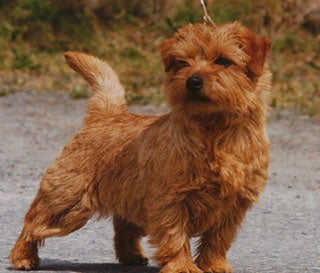Learn about dog breeds
Detailed information & photos on over 190 different breeds
Description
The Norfolk Terrier is a small, hardy and compact dog. He was bred as a working dog that would chase and catch rats and mice. He has short legs, a rounded head, low ears, and a wedge-shaped nose and mouth. The dog has very strong jaws and large teeth for his body size. He has small eyes, strong, average length necks for their size, and their tails are often surgically docked in the US, though in Europe the dog's tail is not docked. Their legs are short and muscular, as the dogs are made for chasing, running, and digging. This breed is much more common in the United Kingdom than they are in the United States.
Coat Description
The Norfolk terrier has a double coat; the outer coat is a protective layer that can reach up to 2 inches long. The under coat and outer coat are very close to the body. The neck hair is longer than the short hair on the dog's head. They have coarser hair on their legs.
The Norfolk terrier can be red, wheat, grizzle, or black and tan.
History
The first Norfolk terriers were noted in the 1880s in England. They were intended as rat hunters and were used in barns. It is thought the breed originated from breeding Cairn Terriers with Irish terriers and with a Gypsy terrier. The dogs were quite popular with Cambridge students; and around the time of World War I, they were brought to the United States. Originally, the Norfolk terrier was classified as a Norwich terrier. The breeds were separated in 1964. the Norfolk terrier has dropped ears, while the Norwich Terrier has pricked ears, and the Norfolk terrier is much more angular than the round Norwich Terrier.
Temperament
Norfolk terriers are best described as being happy, friendly, and fearless. They are loyal to their masters and not aggressive. Unlike many small breed dogs, the Norfolk terrier is not prone to nervousness or excessive barking. As they were intended as pack rat catchers, they are very social with other dogs. They can be jealous if they are not the center of attention, but they do love and play with all member of the family, even children. They can be used as working dogs, though they are too small and too short to use as hunting dogs. In general, the Norfolk Terrier is a wonderful family pet. The only problems he has are a tendency to be a little jealous and need for attention, neither of which are a real problem when the dog is loved and played with adequately.
Health Problems
The most common problem in the Norfolk Terrier is Mitral Valve Heart Disease, which stems from a heart abnormality. Norfolk terriers also can get hip dysplasia and luxating patellas. Both of these problems are joint related, and can develop in the dog later on in life. The problems are genetic and owners should be sure the dog's family line is free from these problems. Norfolk terriers can have an allergic reaction to rabies, parvovirus, and DHLPP vaccines. The reactions are severe and need immediate veterinary attention to prevent death. While it is true that some puppies die from these shots, it is not common and the propensity for these reactions has been traced to specific lines of the breed. As with all congenital and genetic problems, the breeder should be consulted about the individual's family history to be sure these problems are not present. Some Norfolk terriers also have jaw alignment problems that can affect their bite.
Grooming
Simple regular combing of the Norfolk terrier's coat is ample. The dog does not need to be trimmed. Once or twice a week use a steel comb to prevent the hair from matting, and the dog should have a shampoo as often as he needs it. His coat does not shed very much.
Exercise
The Norfolk terrier is a great play companion and loves to be in the yard with his family members. He will also run with his master, or walk with his master, provided the walks and runs are not excessive in time or mileage. The breed loves to chase things like balls and enjoy a game of fetch. They also like to chase people and play with toys like Frisbees. The will hunt small animals in the yard. Especially good exercise for both the physical and mental health of the Norfolk terrier is a dog show. Agility training and competitions are wonderful for this breed.
Training
Training of the Norfolk terrier should begin when the dog is still a puppy. They are rather easy to train and are people pleasers so they are eager to learn. The breed is very smart and can learn a lot of things, especially obedience skills and tricks. The breed can be difficult to housebreak, and the beset way to do this is to use the crate training method. The dogs are quite agile and very able to succeed at many dog trial competitions when they are properly trained.
Advertise | Privacy Policy | Terms of Use | Contact Us © Copyright 2004-2024 PupCity.com. All rights reserved.
